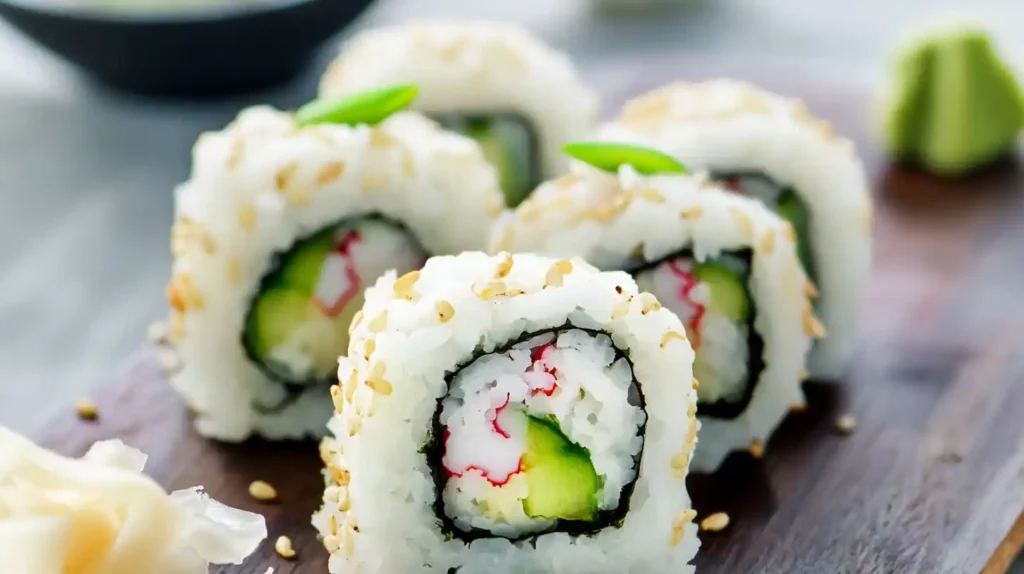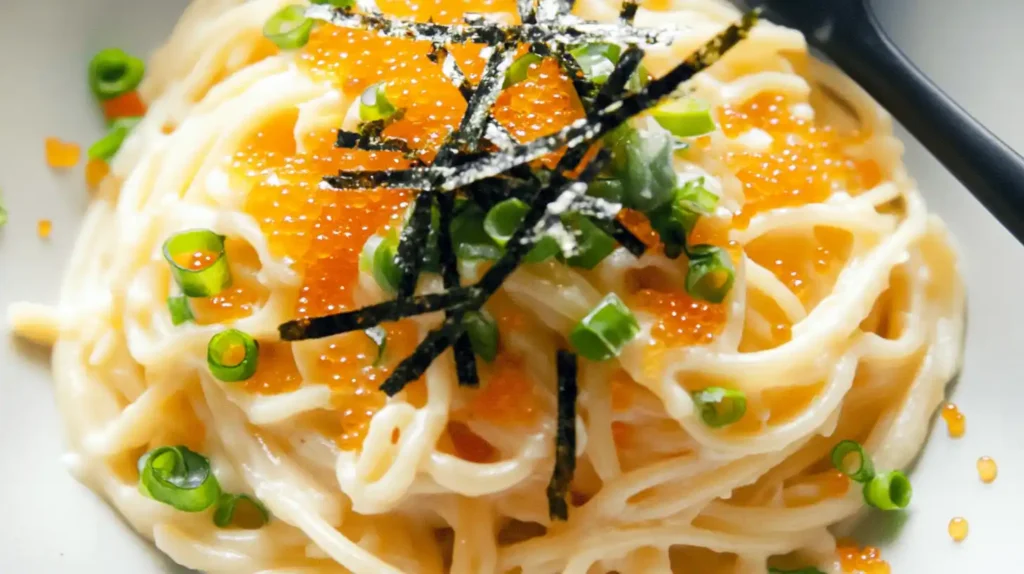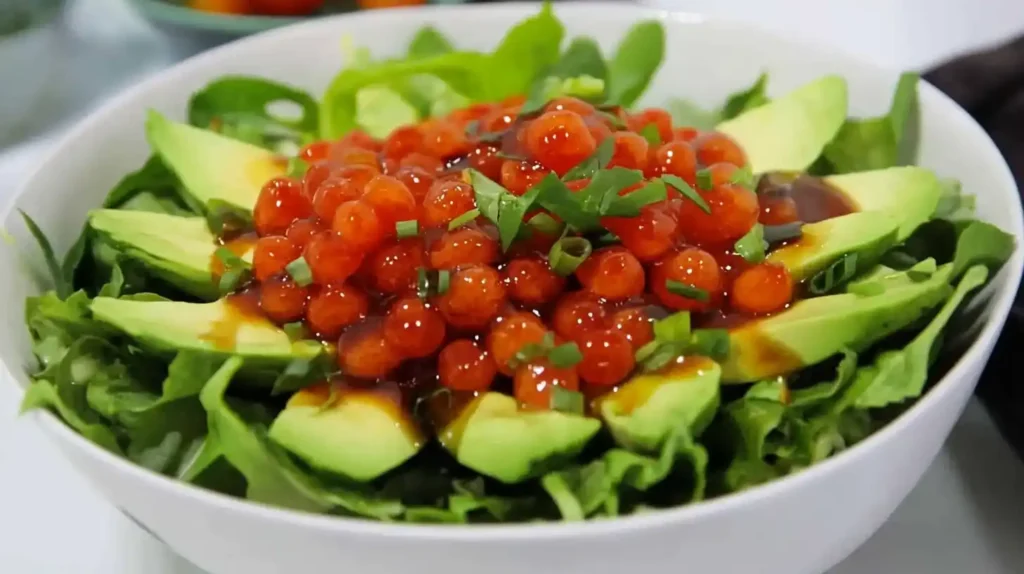Tobiko, or flying fish roe, is a vibrant and delicious ingredient popular in Japanese cuisine. Known for its bright orange hue and subtle smoky flavor, tobiko adds texture, color, and umami to dishes. You might have spotted it topping sushi rolls, adorning sashimi, or even in fusion recipes like pasta and sliders.
Whether you’re a seasoned foodie or just curious about this delicacy, this article is your ultimate guide to tobiko caviar. Let’s dive into what makes it so special, how to use it, and why it’s a must-try for food enthusiasts.
Table of Contents
The Cultural Significance of Tobiko in Japanese Cuisine 🇯🇵
In Japan, food isn’t just sustenance—it’s art, culture, and tradition all rolled into one. Tobiko plays a small but important role in this rich culinary tapestry. Its vibrant appearance and unique flavor make it a popular ingredient in dishes where aesthetics and taste are equally valued. Let’s explore why tobiko holds a special place in Japanese cuisine.
A Symbol of Elegance and Simplicity
Japanese cuisine is deeply rooted in the principles of minimalism and harmony. Every ingredient, no matter how small, contributes to the overall balance of a dish. Tobiko’s bright colors and distinctive texture embody this ethos by:
- Enhancing presentation: The vibrant orange (or green, black, and yellow variations) creates visual contrast, making dishes more inviting.
- Adding dimension: The “pop” of tobiko adds a surprising texture, bringing balance to soft sushi rice or smooth sashimi.
A Staple in Sushi Art
In Japanese cuisine, sushi is more than food; it’s an art form. Tobiko is a favorite ingredient for sushi chefs who use it to:
- Decorate maki rolls, creating intricate patterns.
- Add bursts of color to nigiri or gunkan-maki.
- Highlight the beauty of sashimi platters with its jewel-like appearance.
Its versatility and ease of use make it a common choice for elevating both traditional and modern sushi styles.
Connection to Nature and Seasonality
Japanese cuisine celebrates the seasons, and tobiko ties into this appreciation for nature. The bright orange roe evokes imagery of the ocean, reflecting the Japanese concept of “umami from the sea.” Its subtle smoky-salty flavor complements the freshness of other seasonal seafood.
A Modern Culinary Innovation
Interestingly, tobiko’s popularity in Japan has grown alongside the globalization of sushi. While traditional sushi rarely featured tobiko, modern interpretations embraced it as sushi evolved to suit international tastes. Today, it’s considered a fusion ingredient, bridging traditional Japanese techniques with global culinary trends.
A Symbol of Celebration and Luxury
In Japan, tobiko is often served during celebrations or special occasions. Its luxurious appeal and vibrant color make it ideal for festive meals. While not as prestigious as sturgeon caviar, tobiko’s affordability allows more people to enjoy a touch of elegance in their meals.
By combining aesthetic appeal, unique texture, and deep cultural relevance, tobiko exemplifies the balance and beauty of Japanese cuisine. Whether used in traditional sushi or innovative fusion dishes, this tiny delicacy carries the essence of Japan’s culinary philosophy.
Discover the rich traditions and techniques of Japanese cooking with this detailed guide from Japan National Tourism Organization.
3 Delicious Tobiko Caviar Recipes
1. Tobiko Sushi Rolls (California Rolls with a Twist)

Ingredients:
- 2 cups sushi rice (cooked and seasoned with rice vinegar)
- 4 sheets of nori (seaweed)
- 1 avocado, sliced
- 1 cucumber, julienned
- 200g imitation crab or cooked shrimp
- 4 tablespoons tobiko (orange or flavored varieties)
- Soy sauce, pickled ginger, and wasabi for serving
Instructions:
- Place a bamboo sushi mat on a clean surface and cover it with plastic wrap.
- Lay a sheet of nori on the mat, shiny side down.
- Spread an even layer of sushi rice over the nori, leaving about 1 inch at the top edge.
- Add avocado slices, cucumber, and crab to the center of the rice.
- Roll the sushi tightly using the mat, applying light pressure.
- Slice the roll into even pieces and top each with a small spoonful of tobiko.
- Serve with soy sauce, pickled ginger, and wasabi.
Looking to take your sushi game to the next level? Find out how tobiko can elevate your creations in our guide: How Tobiko Can Transform Your Sushi
2. Creamy Tobiko Pasta

Ingredients:
- 300g spaghetti or zucchini noodles (for a low-carb version)
- 1 tablespoon butter
- 3 garlic cloves, minced
- 1 cup heavy cream or coconut cream
- 2 tablespoons soy sauce
- 4 tablespoons tobiko (any variety)
- 1 scallion, finely chopped
- Optional: 1 teaspoon wasabi paste for heat
Instructions:
- Cook the pasta according to package instructions, or prepare zucchini noodles if going low-carb.
- In a large skillet, melt butter over medium heat. Add garlic and sauté until fragrant.
- Pour in heavy cream and soy sauce, stirring well. Let it simmer for 3–5 minutes.
- Toss the cooked pasta in the sauce until evenly coated.
- Remove from heat, and gently mix in 2 tablespoons of tobiko.
- Plate the pasta and garnish with the remaining tobiko and chopped scallions.
3. Avocado Salad with Tobiko and Honey Balsamic Dressing

Ingredients
For the Salad:
- 2 ripe avocados, cubed
- 1 cup mixed greens (arugula, spinach, or romaine)
- 1/2 cup cherry tomatoes, halved
- 2 tablespoons orange tobiko
- 1/4 cup cucumber, finely diced
- 2 tablespoons red onion, thinly sliced
- Optional: 1 tablespoon crumbled feta cheese
For the Dressing:
- 2 tablespoons olive oil
- 1 tablespoon balsamic vinegar
- 1 teaspoon honey
- 1/2 teaspoon Dijon mustard
- Salt and pepper to taste
Instructions
- Prepare the Salad Base
- In a large bowl, combine the mixed greens, cherry tomatoes, cucumber, and red onion.
- Cube the Avocado
- Carefully cut the avocados into cubes and gently fold them into the salad mix to avoid breaking them.
- Make the Dressing
- In a small bowl, whisk together olive oil, balsamic vinegar, honey, Dijon mustard, salt, and pepper until well emulsified.
- Assemble the Salad
- Drizzle the honey balsamic dressing over the salad and toss gently to coat all the ingredients evenly.
- Add the Tobiko
- Just before serving, sprinkle the orange tobiko evenly over the salad for a pop of color, texture, and flavor.
- Optional Garnish
- Top with crumbled feta cheese for an added layer of creaminess, if desired.
Pro Tips
- Chill the salad ingredients before assembly for a refreshing dish.
- Serve immediately after adding the dressing and tobiko to maintain the crunch and texture.
These recipes are perfect for special occasions or a quick weeknight treat! Which one will you try first?
How to Impress Guests with Tobiko at Dinner Parties
Hosting a dinner party? Tobiko is your secret weapon to create dishes that look elegant, taste incredible, and spark conversation. With its vibrant colors, unique texture, and gourmet appeal, it’s the perfect ingredient to wow your guests. Here are some creative and easy ways to incorporate tobiko into your menu and make your gathering unforgettable.
1. Serve Tobiko Canapés for an Elegant Starter
Start the evening with bite-sized canapés featuring tobiko:
- Cucumber Cups: Hollow out thick cucumber slices and fill them with cream cheese or avocado mousse. Top with a small dollop of tobiko for a pop of color and crunch.
- Blini with Tobiko: Serve mini buckwheat pancakes with a spread of crème fraîche and a spoonful of tobiko.
- Seaweed Crackers: Use crispy seaweed sheets or rice crackers as a base for cream cheese and tobiko.
These hors d’oeuvres are quick to prepare and visually stunning.
2. Create a DIY Sushi Platter
Set up a sushi-making station and let your guests create their own rolls or bowls using tobiko as a topping. Provide:
- Sushi rice
- Nori sheets
- Fillings like avocado, cucumber, imitation crab, and smoked salmon
- Tobiko in multiple colors for variety (orange, green, black, and yellow)
This interactive experience is not only fun but also allows your guests to customize their dishes to suit their tastes.
3. Feature Tobiko in a Show-Stopping Seafood Tower
Nothing says “luxury” like a seafood tower, and tobiko can take it to the next level. Include:
- Oysters on the half shell, topped with a dollop of tobiko and a squeeze of lemon.
- Shrimp cocktail served with a side of tobiko-infused dipping sauce.
- Sashimi or smoked fish garnished with a sprinkling of tobiko.
The bright colors of tobiko will stand out against the fresh seafood, making your presentation look straight out of a fine-dining restaurant.
Love seafood? Learn how to prepare a delicious smoked salmon at home with our step-by-step guide: How to Make Smoked Salmon Brine—perfect to pair with tobiko!
4. Craft Unique Tobiko Cocktails 🍸
Surprise your guests with a tobiko-inspired drink. Rim your cocktail glasses with a thin layer of tobiko for a salty, umami edge. Perfect pairings include:
- A Bloody Mary: Add a spoonful of tobiko for garnish—it pairs beautifully with tomato juice and vodka.
- A Martini: Serve with a small spoonful of tobiko at the bottom for a sophisticated twist.
These drinks are sure to be a conversation starter!
5. Finish with a Tobiko-Themed Centerpiece Dish
For your main course, create a standout entrée featuring tobiko:
- Creamy Tobiko Pasta: Serve a rich pasta dish garnished with vibrant tobiko for a gourmet finish.
- Grilled Fish: Top fillets of white fish with a layer of tobiko butter for a luxurious glaze.
- Tobiko-Stuffed Avocados: Halve and fill avocados with a creamy crab mixture and tobiko topping.
Want to warm up after a sushi night? Don’t miss our Creamy Green Chili Chicken Soup Recipe for a comforting and flavorful bowl of goodness
6. Present Tobiko Like a Chef
Even simple dishes can look sophisticated with thoughtful plating. Use tobiko to:
- Add finishing touches to soups, such as a clear miso broth with floating tobiko pearls.
- Garnish deviled eggs or tartlets with a teaspoon of tobiko for color and texture.
- Create a minimalist plate design by arranging tobiko in geometric shapes or lines.
Pair your tobiko-inspired dishes with a low-carb snack! Try our spicy and flavorful Keto Buffalo Cauliflower Bites for a crowd-pleasing appetizer.
Pro Tips for Maximum Impact
- Use Tobiko Sparingly: Tobiko’s bold flavor means a small amount can go a long way. It’s best used as a garnish or topping.
- Mix and Match Colors: A mix of tobiko varieties (orange, green, black, yellow) makes your dishes even more eye-catching.
- Educate Your Guests: Share a fun fact about tobiko (e.g., its origins or how it’s made) to add an educational and entertaining element to your presentation.
With these tips and ideas, your dinner party will leave a lasting impression. Whether you’re hosting an intimate gathering or a grand celebration, tobiko brings a touch of sophistication that your guests will rave about!
Tips for Serving Tobiko Caviar
Tobiko caviar is a versatile and vibrant ingredient that can transform your dishes into stunning culinary creations. To ensure the best flavor, texture, and presentation, here are some expert tips for serving tobiko like a pro.
1. Keep Tobiko Chilled at All Times
Tobiko is a perishable ingredient and should always be stored properly:
- Refrigeration: Store tobiko in an airtight container in the coldest part of your refrigerator (between 0–4°C or 32–39°F).
- Serving Temperature: Serve tobiko cold to preserve its texture and flavor. Avoid exposing it to room temperature for extended periods.
- Freezing Option: Tobiko can be frozen for up to 3 months. Freeze it in small, portioned amounts to avoid repeated thawing and refreezing, which can compromise quality.
2. Serve Tobiko in Small Portions
Tobiko has a bold, salty flavor that’s best enjoyed in moderation:
- Use small spoonfuls (about 1 teaspoon per serving) as a garnish or topping.
- Pair it with mild, creamy ingredients (like avocado or cream cheese) to balance the saltiness.
- Avoid overwhelming the dish by using too much tobiko, as it can dominate other flavors.
3. Elevate Presentation with Thoughtful Plating
Tobiko’s vibrant colors make it a natural centerpiece for visually striking dishes
4. Pair Tobiko with Complementary Ingredients
The bold flavor and texture of tobiko work best with ingredients that complement its natural characteristics:
- Creamy Textures: Avocado, crème fraîche, or mascarpone balance tobiko’s salty profile.
- Neutral Bases: Rice, sushi rolls, and crackers provide a neutral platform for tobiko to shine.
- Seafood Pairings: Pair with sashimi, shrimp, or oysters for a cohesive umami experience.
- Citrus Accents: A squeeze of lemon or yuzu enhances the delicate flavors of tobiko without overpowering it.
5. Avoid Overheating Tobiko
Tobiko is best served raw or at cool temperatures. Heating it can ruin its texture and reduce its signature “pop.” If you must cook it:
- Add it as a finishing touch to hot dishes, like pasta or soups, right before serving.
- Avoid direct exposure to high heat to preserve its crisp texture and vibrant color.
6. Use Specialty Serving Utensils
To maintain tobiko’s quality and elegance, consider these serving tips:
- Use a non-metallic spoon (wooden, ceramic, or mother-of-pearl) to prevent any metallic taste from transferring to the tobiko.
- Present it in small, elegant dishes like mini bowls or spoons for a refined touch.
7. Experiment with Tobiko Drinks
For a unique presentation, use tobiko in beverages or cocktails:
- Rim cocktail glasses with tobiko for a salty, umami finish.
- Add a small scoop to chilled sake or vodka for an exotic twist.
8. Incorporate Tobiko as a Conversation Starter
When serving tobiko, share its story and unique qualities with your guests:
- Mention that tobiko comes from flying fish and is naturally orange, with variations created using natural infusions (like wasabi or squid ink).
- Highlight its nutritional value, including its high protein content and omega-3 fatty acids.
By following these tips, you’ll not only serve tobiko in its best form but also elevate your presentation and impress your guests with your culinary flair. Whether you’re using it as a garnish or a star ingredient, tobiko brings sophistication and a burst of flavor to any dish.
Nutrition Facts for Tobiko (Per Tablespoon)
| Nutrient | Amount |
|---|---|
| Calories | ~40 |
| Protein | 6 g |
| Omega-3s | 2 g |
| Sodium | ~350 mg |
FAQ About Tobiko Caviar
Here are the most frequently asked questions about tobiko caviar, along with clear and concise answers to help you become a tobiko expert!
Q: What is tobiko?
A: Tobiko is the roe (eggs) of flying fish, known for its vibrant colors, crunchy texture, and smoky, slightly sweet flavor. It’s commonly used in sushi, sashimi, and other Japanese dishes as a topping or garnish.
Q: Is tobiko raw or cooked?
A: Tobiko is cured, not cooked. The curing process involves salt and sometimes natural flavor infusions (like wasabi or squid ink), making it safe to eat right out of the container.
Q: What does tobiko taste like?
A: Tobiko has a mild, slightly salty flavor with a hint of sweetness and a smoky undertone. Its signature crunch adds a unique texture to dishes.
Q: How is tobiko different from other roe like masago or ikura?
- Tobiko: Flying fish roe, known for its small size, crunchy texture, and vibrant orange color.
- Masago: Capelin fish roe, similar in size to tobiko but softer and with a milder flavor.
- Ikura: Salmon roe, much larger, softer, and with a rich, buttery taste.
Q: Can tobiko be frozen?
A: Yes, tobiko freezes very well! Store it in an airtight container or its original packaging for up to 3 months. Divide it into small portions before freezing so you can thaw only what you need.
Q: Is tobiko healthy?
A: Absolutely! Tobiko is rich in protein, omega-3 fatty acids, and essential vitamins (like B12). However, it is high in sodium, so it’s best enjoyed in moderation.
Q: What are the different colors of tobiko, and what do they mean?
A: Tobiko is naturally orange but can be infused with natural ingredients to create vibrant variations:
- Green: Infused with wasabi for a spicy kick.
- Black: Colored with squid ink for a rich, umami flavor.
- Yellow: Infused with yuzu for a tangy, citrusy twist.
Q: How long does tobiko last once opened?
A: When stored properly in an airtight container in the refrigerator, tobiko can last up to 10 days after opening. Always check for any changes in smell or appearance before using.
Q: Can I use tobiko if I have a seafood allergy?
A: No, tobiko is derived from flying fish and is not suitable for individuals with seafood allergies. However, vegetarian alternatives made from seaweed are available as substitutes.
Q: Is tobiko gluten-free?
A: In its natural form, tobiko is gluten-free. However, some varieties may include soy sauce or other seasonings containing gluten. Always check the packaging to ensure it meets your dietary needs.
Final Thoughts
Tobiko caviar is a delightful addition to any kitchen. Its unique flavor, texture, and versatility make it a must-try for adventurous eaters and sushi lovers alike.
If you’re fascinated by tobiko’s colorful varieties, don’t miss our article on Black Tobiko: A Bold Sushi Ingredient to learn more about its rich flavor and dramatic presentation.
Have you tried tobiko in your cooking? Let us know your favorite recipe in the comments below!

